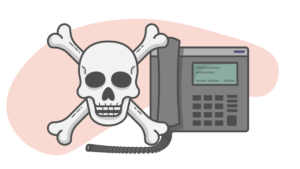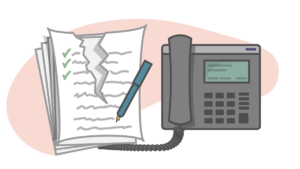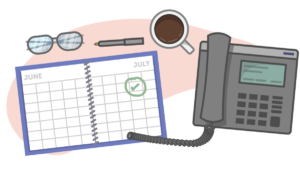
The Ultimate Cold Calling Guide 2021
There are plenty of people who would gladly tell you that cold calling is a waste of time. These folks are usually lousy at doing it themselves, have never sold it professionally, or have a vested interest in preventing you from doing so.
Of course, I don’t think salespeople should forego all other methods of selling in favor of cold calling. There are a variety of mediums that can be used to create new chances, and it makes no sense to dismiss one merely because another is accessible. There is nothing about any medium that makes it a one-of-a-kind option. You employ several tools for various reasons, much like a toolbox.
If done correctly, cold calling may help you prospect, build relationships, and increase conversions. In this article, I’ll show you why cold calling is still relevant and how you can become an effective cold-calling powerhouse in no time.
Chapter 1: A Rebuttal to Cold Calling
Salespeople are frequently divided into two camps: those who believe cold calling is still necessary and those who believe social selling has taken its place. Those in one group usually believe that their way is the greatest and that the other is ineffective. Cold calling, which salespeople despise, has been used as a straw man by those who favour social selling to have something to rail against in order to win clients. This is simply not an effective sales strategy.
This post was published by my pals at Sales for Life as proof that the cold is on its way out. Here is a list of their claims, as well as some proof to the contrary.
Cold calling has a low conversion rate, with only 28% of calls resulting in a dialogue.
The Keller Study Center’s research is used in the article to illustrate that cold calling has a 1% conversion rate. They omitted to note that this study was based on real estate agents, not business-to-business salespeople. Even yet, it would be more than adequate if I could chat with three out of every ten people I met.
According to Forrester, 37% of order takers and 27% of explainer personas will be displaced.
People dislike cold calling for the same reason they dislike order takers and explainers: they dislike conflict. You fall into the category of order-taker or explainer if you hide behind social media and use emails.
B2B e-commerce is expected to reach 1.1 trillion dollars, accounting for 12.1% of total B2B sales.
Whether you ignore cold calling or not, that number will continue to rise. It says nothing about the opportunities you’re passing up by not responding to cold calls.
Cold outreach is ignored by nine out of ten top-level decision-makers.
This is true if you have nothing to do in your spare time. That, however, only speaks to your abilities, not to the medium. It will hurt you if your competitor picks up the phone and engages them while you do not.
75 percent of B2B executives claim they use social media in their decision-making process on a frequent basis.
They certainly do. As a result, using the phone in conjunction with social media is the most effective strategy.
According to Salesforce, 74% of buyers choose a salesperson who is the first to give value and insight.
But, with so much noise on social media, how do you get your worth and expertise noticed? Cold calling is still the quickest approach to getting in front of a client.
The great majority of B2B decision makers can not be reached by cold calling. 84 percent of B2B executives begin their buying journey using referrals.
Seriously? When it comes to asking for referrals, the same people who are afraid of the phone are even more hesitant. Why sit around and wait for your pipeline to fill up when you can make a call?
According to Forrester, 70 percent of executives believe salespeople are unprepared to answer their queries, and “there is no way a cold call salesperson can be as prepared as a social seller.”
It’s possible that this is true for folks who aren’t very good at cold calling. When you get better at it, you’ll be able to answer any question.
Only two attempts are made by the average salesman to contact a prospect.
“Success in social media necessitates a large number of touch points delivered through a variety of channels.” That isn’t social success; it is prospecting and relationship development success. The phone should be one of those finishing touches. Another option is face-to-face communication. Make use of social media as well.
None of the data they supplied provided a compelling justification for cold calling; it only confirmed that individuals dislike doing it, not that it is ineffective.
Chapter 2: Using Cold Calling and Social Media
Is it a good idea to use social sales? Should you be making cold calls? Here, there are two camps.
One person believes that you should never call people at work, that you should never interrupt someone to ask for an appointment, and that you should never ask someone to buy something. Always connect instead of close up. You can then let the customer decide whether or not they want to continue listening or make a commitment.
The other camp believes that the phone is still a crucial tool, and that if you want to get results quickly, you should pick up the phone and contact proactively targeted clients so you can meet them face to face and begin establishing an opportunity. This organization will also advise you to sell on social media. They’ll advise you to seek out referrals. They’ll advise you to attend social networking events, seminars, and trade exhibits, among other things. They’ll tell you to prospect using every accessible strategy, including cold calling, in order to establish a balanced approach that works for your company.
So, who is correct?
It has to be the people who advise you to do cold calls. It’s more efficient, productive, and effective at filling your calendar with appointments quickly. Social selling is a time-consuming process that wastes a lot of time and money. There isn’t much of a debate here. Every professional will tell you that using every approach available to you is the greatest way to guarantee that you receive the results you require. LinkedIn isn’t used by everyone. Networking events are not for everyone. You WILL notice better outcomes if you use all of the methods accessible to you.
With partnerships that began on social media, such as LinkedIn, Twitter, and my blog, I’ve earned a large account. Inbound marketing and social media are useful and occasionally effective techniques.
However, telling salespeople that they don’t need to do cold calls constitutes criminal negligence (or picking up the telephone).
If you’re a young person who shudders at the prospect of making a cold call, getting used to it will help you obtain results faster and expand your pipeline. If you’ve been in the industry for a long time, you should also create a good LinkedIn profile and pick up the phone.
Both social selling and cold calling are more effective when used jointly. It’s only a matter of common sense.
Chapter 3: Scripts and Cold Calling Truth
Let’s face it, we’ve all seen how scripts can go tragically wrong. I was given a cold calling script when I first started in sales. It was made out of a stack of index cards kept in a little binder. The prompts were labelled on the tabs of each card. The concept was that as soon as a prospect raised an objection to meeting with you, you could go to the appropriate tab and find the words you needed to overcome it.
On my first or second day of calls, I was halted in the middle of a pitch by a prospect who stated, “Hey, you’re reading from a script.” When you don’t need to read a screenplay, give me a call. ” I couldn’t get any guidance from the tabs on that one.
It’s true that if you sound like you’re reading from a script, your sales prospects will lose faith in you. Scripts, on the other hand, aren’t magical. With experience and patience, you will get more comfortable with them. As I continued to make calls, I discovered that having access to effective language helped me avoid being caught off guard when objections arose. I discovered that as my skills and confidence grew, I no longer needed the cards. They were, however, a huge crutch at first.
Scripts are already being used by some of you.
Scripts are already being used by you, whether you realize it or not. Unless you’re conversing with a client in a completely new way every time, you’re following a script. Even when you’re speaking with your ideal client, you’re probably still giving stock responses to common issues and worries. It is not intended for scripted language to read like a screenplay. The idea is that they supply suggested wording, which you then study in order to fine-tune your response to each client.
Spend time crafting and practicing your message.
If you’re new to sales, producing scripts is an excellent way to ensure that you’re on track and that your message is clear and simple. Even if writing scripts is second nature to you, it’s still a good idea to revisit your language and make changes now and again. Taking the time to think about, write down, and practice the language will increase your confidence and proficiency.
Give it a shot. Make a list of the most typical client and prospect communications you have and a rough outline of the main themes and questions you’d like to ask. Keep your final goal in sight at all times. This will boost your ability to make cold calls as well as your confidence in doing so.
This isn’t the time to invent the wheel. Consider what has previously worked for you. What has been your most successful opening in the past? What story best exemplifies the argument you’re trying to make? What amusing anecdote always manages to de-stress the situation? What are the most effective transitions?
Make sure you have a terrific sales call opener, a great value proposition, a stunning and unique series of needs-analysis questions that demonstrate your business acumen, a presentation that defines and validates your capacity to generate results, and tried and tested commitment-getting language.
Chapter 4: Why Do People Fail at Cold Calling?
Cold calling can be effective if done correctly. There are a variety of reasons why people are unable to make it work. Let’s take a look at a few of the most important things.
You aren’t making nearly enough phone calls.
Making 6-10 calls every day is insufficient to offer oneself a reasonable chance of success. You’ll need a research target list and 60 to 80 quick calls to make cold calling work. That way, you’ll be able to get appointments and get better more quickly.
Proposition with low value
If your cold calls aren’t yielding results, it’s likely that your sales call value proposition isn’t strong enough. Most people would be surprised if I asked whether I could “stop by to present myself and my services.” To make cold calling effective, you need to request a meeting where your ideal client can see the value of what you’re offering.
Obtaining large commitments early on
With an open-ended “ask,” it’s easy to scare your client away right away. Even requesting an hour can be excessive at times. To make it more bearable, ask for a shorter commitment, such as 20 or 30 minutes. That way, people can say yes while also having the option to leave early if they don’t see the value.
Chapter 5: Making a Cold Call: Planning and Preparation
Every interaction you have with your customers is important. The initial cold call should make you sound like someone who adds value to their customers. It will determine whether you are someone with whom they should spend more time or whether they should object. This means that you must prepare for sales calls and arrange for them as if they were important.
Come up with solutions.
More collaboration is required in the development of solutions. More stakeholders from various sections of business should be included. It’s all about pitching with less.
Negotiate the Price
You owe it to your client, your company, and yourself not to let them skimp on the results they require. Allowing your client to underinvest by offering discounts is a form of underinvestment. It means you’re depriving your company of the profit it requires to deliver the results you desire to your customers. It also minimizes the value you add.
Take the time to plan and practice your phone call.
A call should never come across as scripted. But it doesn’t rule out the possibility of becoming fluent in all of the lingo required to make it work. Make a list of the most common questions and goals you encounter during sales conversations. Begin with the objections you encounter during your prospecting efforts. Finally, as your prospects and dream clients are resolving their issues, end with the objections you encounter late in the process. In an outline, write out everything that happens in between.
represents the procedure from start to finish Choose the most effective words, phrases, and stories that will assist in the resolution of your difficulties. Consider what has worked in the past, and keep track of new questions and concerns, as well as your solutions.
Chapter 6: Six Principles for Cold Calling
You will succeed if you approach cold calling with these six concepts in mind.
You’re going to get a negative response. Believe it or not, it doesn’t mean anything.
Your clients will say no to everyone the first time they hear from you, since they have no means of knowing who is worth their time. Those who excel at cold calling and telemarketing have no concept of what the word “no” means. It’s just a natural part of the process.
Your ideal client is bombarded with phone calls. You must set yourself apart from the crowd.
You must set yourself apart from your competitors. They frequently make an effort to appear professional. You must have a distinct voice. Being genuine, conversational, and genuine will help you stand out from the crowd. If you don’t seem enthusiastic about meeting with them and assisting them, you’ll fit in with the crowd. Be yourself and be self-assured.
You must demonstrate that you are a value creator. This isn’t a timer.
You only get one chance to make a good first impression and persuade a client that you will provide them with value. You sound like a value creator if you say, “I’d like to sit down with you for fifteen minutes to see how we might be able to help reduce your overall cost and improve your results.”
You’ve already got a script in place. Write One That Is Better.
Even if you don’t utilize a written script, you’re probably saying the same thing on every call you make. Your results will improve if you tweak your script.
It is really beneficial to practice writing down what you intend to say before actually saying it. It aids in the integration of language into your neural system; it makes language a natural part of you.
Your objective is to make an appointment. There’s nothing else.
Your sole objective is to secure an appointment. They will say no if you address a client’s inquiries without moving the conversation to an appointment. It’s more likely that you’ll get in the door if you tell them you can supply them with that information as well as details on how you can assist them.
If you want an appointment, you’ll have to push it.
It’s unlikely that you’ll get through to the person you need on your first call. If you’re serious about getting the appointment, you’ll have to call more frequently than you’d like. You must be persistent and tenacious.
Making cold calls is a difficult task for many salesmen. However, there are some concepts that, if taken to heart and put into practice, can significantly improve the effectiveness of your cold calling. Only by chasing every option accessible to you can you ensure that you are establishing contacts and driving sales – and cold calling offers tremendous value.












